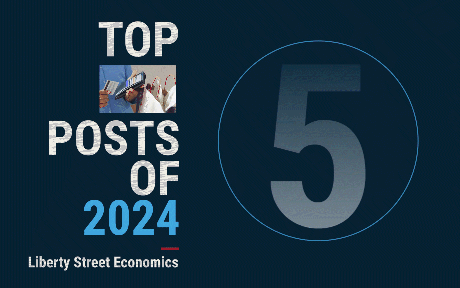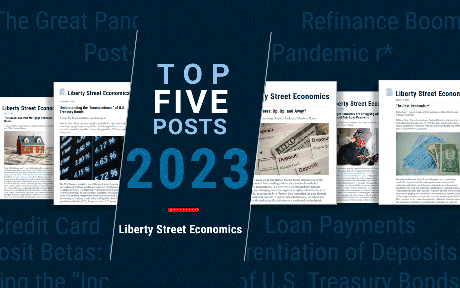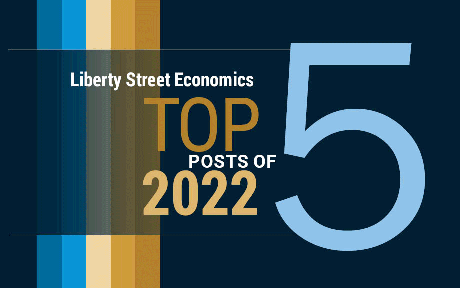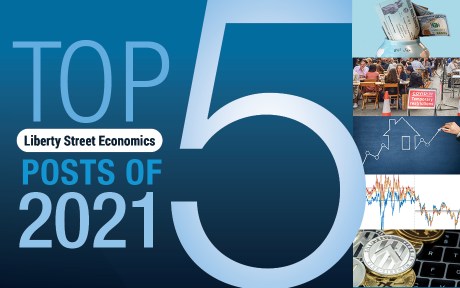
High prices and rising debt put pressure on household budgets this year, so it’s little wonder that the most-read Liberty Street Economics posts of 2024 dealt with issues of financial stress: rising delinquency rates on credit cards and auto loans, the surge in grocery prices, and the spread of “buy now, pay later” plans. Another top-five post echoed this theme in an international context: Could the U.S. dollar itself be under stress as central banks seemingly turn to other reserve currencies? Read on for details on the year’s most popular posts.

By Andrew F. Haughwout, Donghoon Lee, Daniel Mangrum, Joelle Scally, Wilbert van der Klaauw, and Crystal Wang
U.S. credit card holders were utilizing about 23 percent of their aggregate credit limit as of the first quarter of 2024, on par with the levels seen in previous quarters. That aggregate figure, however, masks considerable variation in utilization rates across individuals, with 18 percent of credit card holders effectively “maxed out” (using at least 90 percent of their available credit). In this post, analysts from the New York Fed’s Center for Microeconomic Data (CMD) explore the relationship between credit card delinquency and changes in credit card utilization rates. (May 14)

By Thomas Klitgaard
Since the start of the pandemic, the consumer price index for groceries has outpaced the overall price index. One factor has been commodity prices, which surged from early 2021 to mid-2022. In addition, wages for grocery workers have increased faster than those for the workforce as a whole. Taking a close look at the underlying data, the author suggests that the moderation in food inflation seen since 2023 is due to a retreat in commodity prices, a trend that has offset still-high wage inflation for grocery workers. (July 16)

By Andrew F. Haughwout, Donghoon Lee, Daniel Mangrum, Joelle Scally, Wilbert van der Klaauw, and Crystal Wang
Motor vehicles saw some of the most pronounced and persistent price increases during the pandemic inflationary episode, as chip shortages and supply chain woes limited production. Consumers’ auto loan balances rose accordingly, with the value of the average car loan climbing from about $18,000 in early 2020 to reach nearly $24,000 by the end of 2022. In this post, CMD researchers examine which borrowers are struggling to keep up with auto loan payments. (February 6)

By Patrick Douglass, Linda S. Goldberg, and Oliver Z. Hannaoui
Global central banks and finance ministries hold an immense amount of U.S. dollar assets in their foreign exchange reserves, but the dollar’s overall share of those portfolios has decreased in recent decades. While that decline has given rise to a narrative about the dollar’s loss of status in the international monetary system, the authors argue instead that the aggregate trend largely reflects the actions of a small number of countries. (May 29)

By Felix Aidala, Daniel Mangrum, and Wilbert van der Klaauw
In this post, the authors shed light on the function of “buy now, pay later” (BNPL) plans in users’ household finances, focusing on how usage varies by level of financial fragility. Their results reveal substantially different use patterns across consumers, with more-fragile households tending to utilize BNPL services to finance frequent, relatively small transactions—purchases they might have trouble affording otherwise. (February 14)
How to cite this post:
, “Every Dollar Counts: The Top 5 Liberty Street Economics Posts of 2024,” Federal Reserve Bank of New York Liberty Street Economics, December 23, 2024, https://libertystreeteconomics.newyorkfed.org/2024/12/every-dollar-counts-the-top-5-liberty-street-economics-posts-of-2024/
BibTeX: View |
Disclaimer
The views expressed in this post are those of the author(s) and do not necessarily reflect the position of the Federal Reserve Bank of New York or the Federal Reserve System. Any errors or omissions are the responsibility of the author(s).













 RSS Feed
RSS Feed Follow Liberty Street Economics
Follow Liberty Street Economics